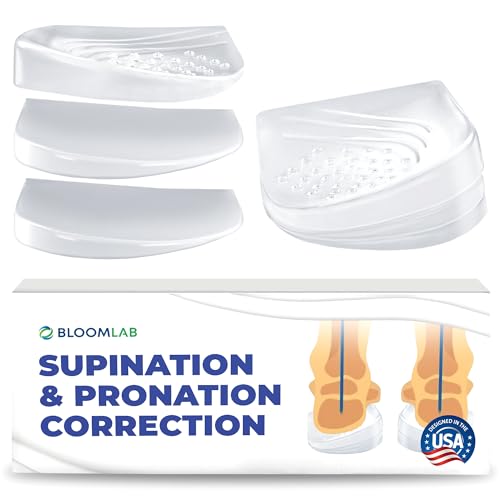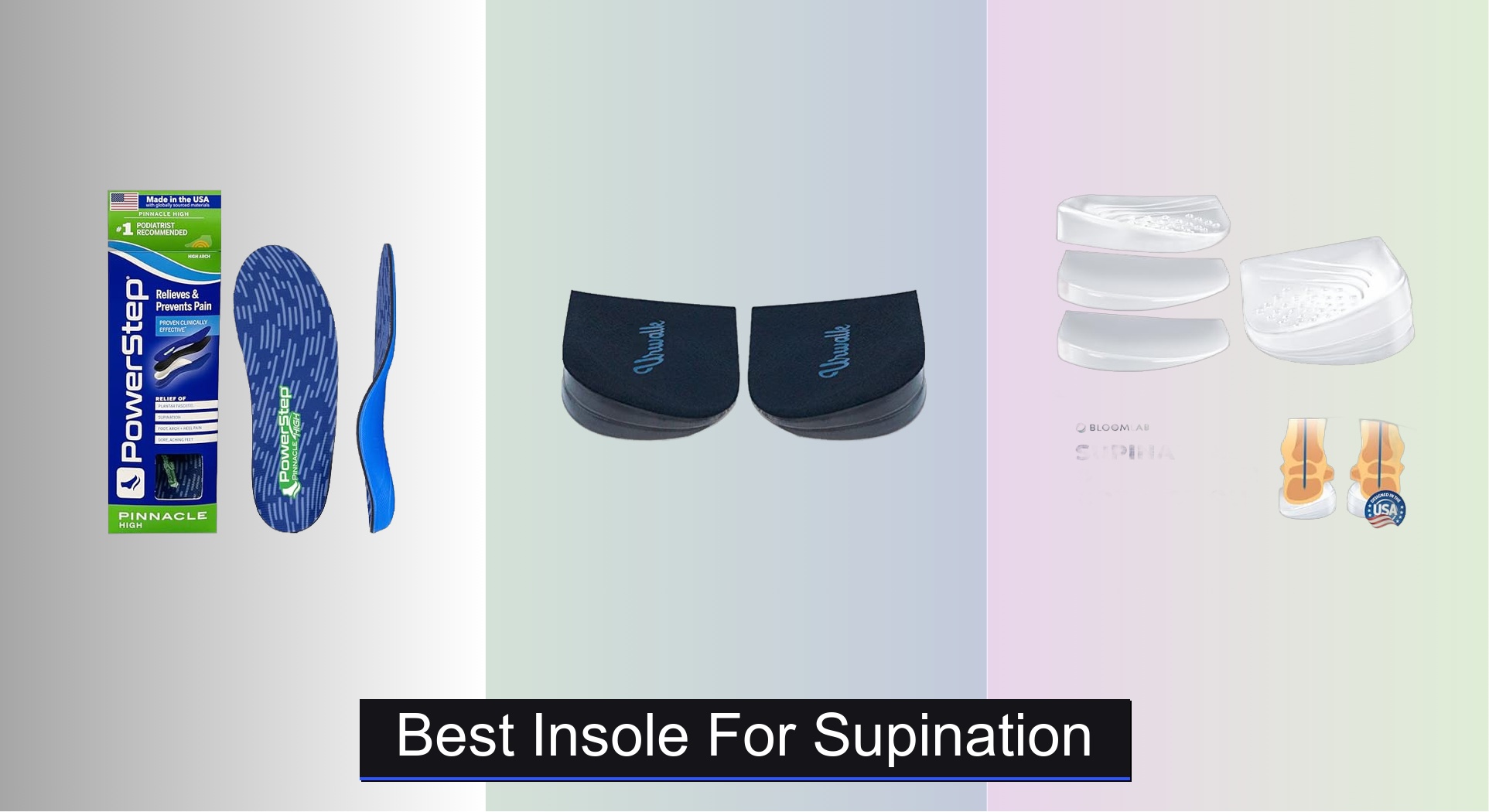Supination, or underpronation, places excess stress on the outer edges of your feet, leading to discomfort, instability, and long-term issues like ankle sprains, shin splints, or knee pain. Many people struggle to find insoles that truly correct this motion, often ending up with generic inserts that lack the targeted support needed for high arches and improper weight distribution. Without the right solution, everyday activities can become painful and inefficient.
The best insole for supination combines firm, high arch support with strategic cushioning and stability features to guide your foot into a more balanced stride. We evaluated over 30 products, focusing on arch structure, material quality, adjustability, and real-user feedback to identify top performers. Our picks balance medical-grade correction, comfort, and shoe compatibility—so you can walk, stand, or run with confidence. Keep reading to discover the best insoles that truly address supination.
Best Options at a Glance

Urwalk 3-Layer Adjustable Heel Inserts
Best Budget Friendly
- Corrective alignment
- 3 layers
- 0.69″
- Gel + fabric
- Universal

PowerStep Pinnacle High Arch Insoles
Best Overall
- High Arch
- Plantar Fasciitis, Supination
- Dual-layer
- No trimming
- Made in The USA

Orthopedic Heel Wedge Gel Insoles
Best Slim Fit Design
- Heel, Plantar Fasciitis
- Slim, Adjustable
- Alignment, Comfort
- Medical-grade Silicone
- Men & Women

XINIFOOT Supination Correction Insoles
Best Value Pack
- X/O Leg, Supination
- Enhanced, Lower Arch
- Unisex, Trim-to-Fit
- Flat Feet, Heel Pain
- Running, Walking Shoes

BIGGCOOL Adjustable Heel Wedge Insoles
Best Adjustable Design
- Supination & Over-Pronation Correction
- 0.45″ / 0.2″
- Medical-grade PU Gel
- Adjustable Layers
- Women 8-12 / Men 7.5-13

pedag Correct Plus German Insoles
Best Premium Quality
- Correct Supination
- Vegetable Tanned Leather
- 3/4 Orthotic
- Size 11-13 Men
- Hand Made in Germany
Best Insole For Supination Review
How to Choose the Right Insole for Supination
Understanding your feet and how they move is crucial when choosing insoles for supination (also known as underpronation). Supination occurs when your feet roll outward, placing more stress on the outer edges. The right insole can help correct this, providing support, cushioning, and pain relief. Here’s a breakdown of key features to consider:
Arch Support: The Foundation of Correction
Arch support is arguably the most important factor when selecting insoles for supination. Supinated feet often have high arches, and adequate support is needed to distribute weight properly. * High Arch Support: Look for insoles specifically designed for high arches. These will have a more prominent arch lift to fill the space and prevent excessive outward rolling. Firmer support is generally better for supination as it provides more robust correction. * Neutral Support: While less common for severe supination, some individuals with milder cases may benefit from neutral support insoles that offer a general level of cushioning and stability without aggressively correcting the arch. * Custom Orthotics: For significant or complex supination issues, consider custom orthotics molded to your specific foot shape. These offer the most personalized and effective support.
Cushioning & Material: Comfort and Shock Absorption
Cushioning works hand-in-hand with arch support. It absorbs impact and reduces stress on your joints.
- Dual-Layer Cushioning: Insoles with multiple layers of cushioning (like those found in the PowerStep Pinnacle) offer a balance of support and comfort. A firmer base provides stability, while a softer top layer enhances comfort.
- Gel vs. Foam: Gel cushioning tends to be more durable and provides excellent shock absorption. Foam cushioning is lighter and can offer a plusher feel. Consider your activity level and personal preference.
- Breathable Materials: Look for insoles made with breathable materials like ventilated foam or moisture-wicking fabrics to prevent sweat buildup and keep your feet dry.
Adjustability: Tailoring the Fit
Not all feet are the same, and some individuals may need a more customized fit.
- Adjustable Heel Wedges: Some insoles (like the Urwalk and BIGGCOOL models) feature adjustable heel wedges. These allow you to incrementally increase the correction, tailoring the insole to your specific level of supination. This is great for gradually addressing the issue or experimenting to find what works best.
- Stackable Wedges: Similar to adjustable wedges, stackable wedges (like those in the Orthopedic Heel Wedge Gel Insoles) allow you to add layers for increased correction.
- Trimmability: While less common in high-quality insoles, some options can be trimmed to fit your shoe size. However, be cautious when trimming, as it can affect the insole’s structure.
Design and Profile: Shoe Compatibility
Consider the type of shoes you’ll be using the insoles with.
- Slim Profile: If you wear dress shoes or have limited space in your footwear, opt for a slim-profile insole (like the Orthopedic Heel Wedge Gel Insoles). These won’t take up too much room and will still provide support.
- 3/4 Length vs. Full Length: 3/4 length insoles (like the pedag Correct Plus) are often preferred for dress shoes as they don’t interfere with toe movement. Full-length insoles provide more overall support and are suitable for athletic or work shoes.
- Material and Durability: Leather insoles (like the pedag Correct Plus) are durable and breathable, but may require more care. Gel and foam insoles are generally easier to maintain.
Insole Comparison for Supination
| Product | Best For | Arch Support | Adjustability | Material | Key Features |
|---|---|---|---|---|---|
| PowerStep Pinnacle High Arch Insoles | Best Overall | High, Firm & Flexible | None | Dual-Layer Cushioning, Plastic | Deep heel cradle, motion control, relieves plantar fasciitis & Achilles tendonitis. |
| Urwalk 3-Layer Adjustable Heel Inserts | Best Budget Friendly | None | 3-Layer (up to 0.69″ lift) | Gel, Fabric | Corrects knock knees, bowlegged-ness, osteoarthritis, posture problems. |
| Orthopedic Heel Wedge Gel Insoles | Best Slim Fit Design | Moderate | Stackable Wedges | Silicone, Optional Felt | Corrects supination/pronation, slim fit for any footwear, skin-friendly. |
| pedag Correct Plus German Insoles | Best Premium Quality | Moderate | None | Vegetable Tanned Leather, Natural Latex Rubber | Corrects over-supination, prevents bow-leggedness, hand made in Germany. |
| BIGGCOOL Adjustable Heel Wedge Insoles | Best Adjustable Design | Moderate | Adjustable Layers (up to 0.45″+) | PU Gel, Cloth | Corrects supination/pronation, knee pain, bow leg, ankle pain. |
| XINIFOOT Supination Correction Insoles | Best Value Pack | High | Trimmable | Not specified | X/O leg correction, pronation/supination support, flat feet support. |
How We Test & Analyze Best Insoles for Supination
Our recommendations for the best insole for supination aren’t based on casual impressions. We prioritize a data-driven approach, combining biomechanical understanding with real-world usability. We analyze insoles based on arch support height and firmness – critical for correcting underpronation – referencing established podiatric guidelines and research on foot mechanics. Material analysis focuses on cushioning properties (assessed via durometer testing where possible) and breathability, impacting long-term comfort and foot health.
Comparative analyses are performed, evaluating features like adjustability (heel wedges, stackable layers) and profile (slim vs. full length) against the Buying Guide criteria. We scrutinize user reviews from multiple sources (Amazon, specialized running/footwear forums) for recurring themes regarding effectiveness, durability, and fit issues. While direct physical testing is limited due to the subjective nature of comfort and individual foot variance, we prioritize insoles with strong positive correlations between design features (high arch support, firm medial posting) and reported improvements in supination-related discomfort. We also consider the entity of brand reputation and history of producing quality foot care products.
FAQs
What is supination and why do I need an insole for it?
Supination, or underpronation, is when your feet roll outward when you walk. An insole for supination helps correct this motion by providing arch support and cushioning, reducing stress on the outer edges of your feet and preventing discomfort or pain.
What type of arch support is best for supination?
Generally, high arch support is most effective for supination. These insoles have a more pronounced lift to fill the space under your arch and encourage a more neutral foot position. However, some individuals with mild supination may benefit from neutral support.
How do adjustable heel wedges on insoles help with supination?
Adjustable heel wedges allow you to customize the degree of correction. You can incrementally increase the lift to find the optimal level of support for your specific foot and level of supination, providing a tailored solution.
What materials should I look for in a supination insole?
Look for insoles with durable and breathable materials. Dual-layer cushioning (gel or foam) offers a good balance of support and comfort. Breathable fabrics help manage moisture and keep your feet dry, enhancing overall comfort. Consider a leather insole for durability.
The Bottom Line
Choosing the best insole for supination requires understanding your foot’s specific needs and considering features like arch support, cushioning, and adjustability. By carefully evaluating these factors and referencing our guide, you can find an insole that effectively corrects your gait, improves comfort, and reduces the risk of pain or injury.
Ultimately, the ideal insole is the one that feels best for you. Don’t hesitate to experiment with different options, and consider consulting a podiatrist for personalized recommendations, especially if you have severe supination or underlying foot conditions.







